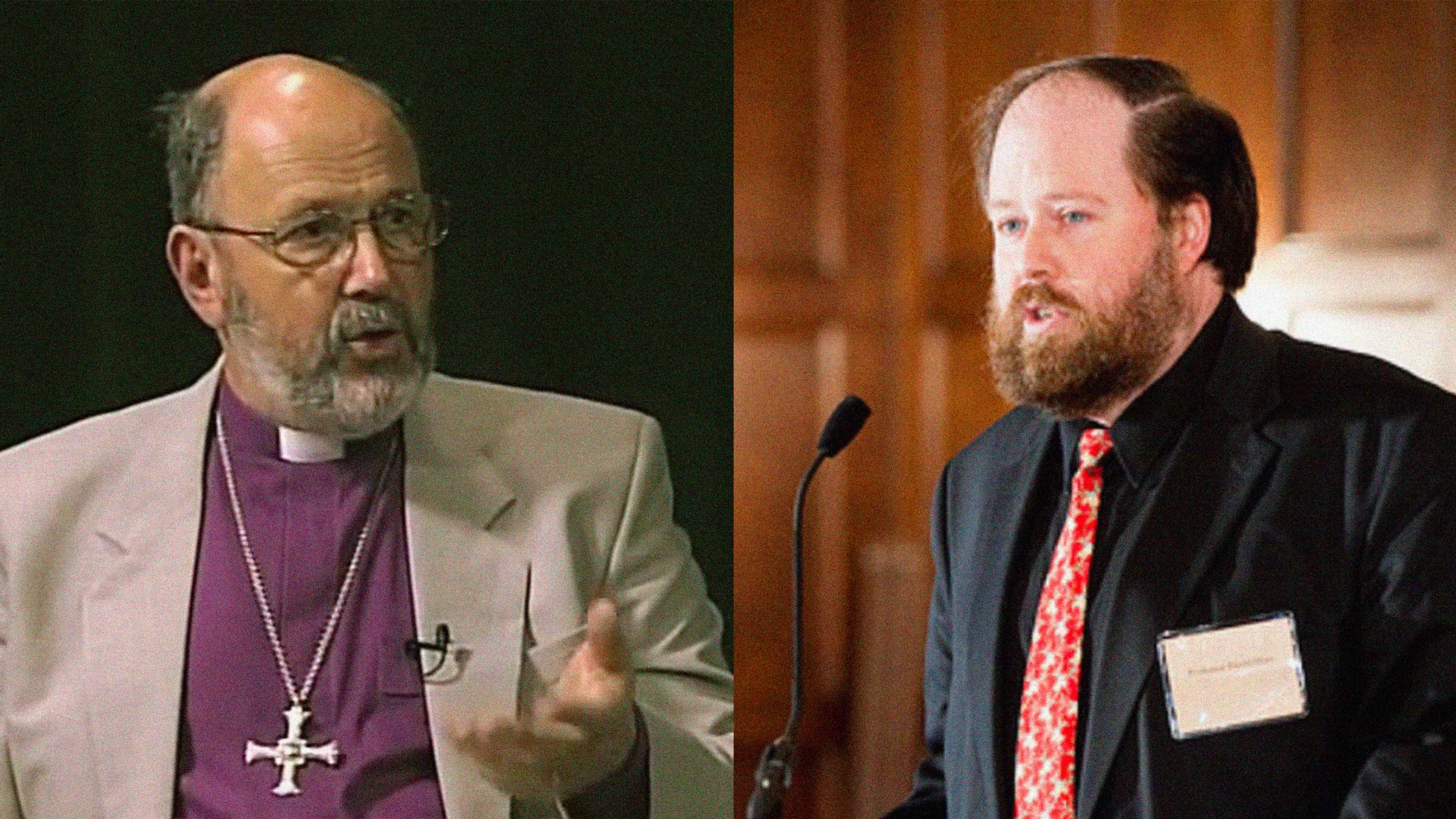Individual translations of the Bible have a long history in Western Christianity, stretching back to Jerome’s Latin translation, the Vulgate. Notable members of this auspicious tradition include William Tyndale, John Wycliffe, and Martin Luther. Much more recently, figures such as Kenneth Taylor and Eugene Peterson have joined their ranks with popular paraphrases, while scholars such N. T. Wright have also produced more traditional translations. (For those interested in more coverage of Bible translations, CT has an in-depth look at lesser-known translations in the upcoming March issue.)
The newest member of this unique club is Orthodox theologian and scholar David Bentley Hart, who published his own translation of the New Testament last year.
Hart’s translation has been making waves, to say the least. Variously described as “mind-bending,” “provocative,” and “a glorious failure,” Hart’s rendering of the New Testament has produced no shortage of commentary, and more than a little critical praise.
Wright’s Review
One notable scholar who does not appear to be particularly impressed by Hart’s translation is Wright, who is probably the closest thing current New Testament scholarship comes to having a celebrity. His review of Hart’s New Testament, published January 15 in The Christian Century, details a lengthy list of disagreements with Hart’s translation choices, and ends with the backhanded compliment that Hart’s translation is “as idiosyncratic as it is bold.”
Wright’s primary concern seems to be Hart’s understanding and use of language—both Greek and English. Hart claims his translation will in many parts be “an almost pitilessly literal translation,” intending to “make the original text visible through as thin a layer of translation as I can contrive to superimpose upon it.”
While Wright seems to respect what Hart is trying to accomplish, he nevertheless argues that instead of making the original text visible, Hart may actually be obscuring it by trying to render Greek syntax and idioms in English. “Greek and English, as Hart knows well, do not work the same way,” Wright argues. “… The strange English here has nothing to do with a cultural clash between the first Christians and ourselves.”
Wright’s review, delivered with classic British understatement, is no less trenchant for its seemingly good-natured tone. Translation is hard, and the effort required also makes it personal, so Wright’s negative appraisal comes with an extra sting. What must Hart think?
We needn’t have wondered.
Hart’s Response
Last Tuesday, a mere 24 hours after Wright’s review was published online, Hart posted a response on an Eastern Orthodox blog run by Aidan Kimel, leaving no doubt about just what he thought of Wright’s evaluation of his translation. The parenthetical prologue speaks for itself:
wherein, at long last, our author unburdens himself of a great number of complaints he has long wished to make against that pious man’s earnest but problematic approach to the New Testament, embellished with a few moments of sly mockery, but ultimately intended as a good-natured—albeit inflexible—expression of deep disagreement
Hart’s rejoinder is, like Wright’s initial review, full of zingers and jabs and worth a full read. Hart grants Wright a few basic premises, then wades right into the details of Wright’s critique—meeting him point for point, and then some. Hart notes in the comments on the blog post that he was “annoyed … that Wright wrote any review at all … because he has a competing version out there [published in 2011], and it’s an old rule that one doesn’t write reviews—especially caustic reviews—of competing books.”
Hart characterizes Wright’s review as a “catalogue of complaints,” and thinks that Wright’s own work “suffers from a dangerous combination of the conventional and the idiosyncratic, with a few significant historical misconceptions mixed in … imposing meanings on the text that best conform to his own convictions, plausible or not.” Hart concludes one particular point about how to translate a noun in Greek that lacks an article by saying, “Here I am right and Wright is wrong,” but it would not be a stretch to say that this statement characterizes much of Hart’s response.
While the verbal sparring is both sharp and entertaining (and perhaps off-putting to certain sensibilities), there is a valuable point at the heart of this debate—one that is worth noting as these two Bible scholarship heavy-hitters take swings at each other’s work.
A Question of Authorial Intent
The disagreement stems not so much from the particulars of Hart (or Wright’s) New Testament translation, but why we translate and what translations are or should be. The specifics that each scholar brings up are sort of like exhibits in a court case to indicate that their opponent has the wrong idea about what translation is and does.
Hart himself locates much of the disagreement as being representative of “traditional disagreements between proponents of ‘dynamic’ and ‘formal’ equivalence” translations, but it’s not clear that’s actually what is at issue here.
Dynamic equivalence aims at what the text meant to its original audience, and tries to cast that meaning in contemporary vocabulary and idioms; it is sometimes described as a “thought for thought” translation philosophy. Hart places Wright in this camp. By contrast, formal equivalence aims at what the text originally said in its original form, attempting to render the modern language equivalents of the base language words and phrases: “word for word” translation. This is what Hart aims to do.
In his introduction and postscript, Hart lays out his goal, which is to develop a translation that hews to the literal rendering of the Greek originals as closely as he can, while also retaining the unique and often jarring voice and style of the original authors. As many reviewers have noted, this is precisely the value of Hart’s translation, it allows those familiar with Scripture to read it “again for the first time.”
Interestingly, Wright has similar aims for his own translation. In the introduction to his own New Testament translation, Wright states that “it’s a translation, not a paraphrase” and that he’s “tried to stick closely to the original” in order to give readers a “first hand, rather than second hand, understanding of what the New Testament said in its own world.”
But unlike Hart, who commits to making his translation “pitilessly literal” at points, Wright acknowledges that “there are always going to be places where you simply can’t do it word by word.” Does this make Wright’s translation “dynamic” where Hart remains “literal”?
At this point, Wright’s question to Hart from early in his review is very fitting: “But what does literal mean?”
Making Sense of the Debate
Translation is by nature “dynamic,” as it aims to communicate what was delivered in one language in the words of another language. As Wright notes, “Greek and English, as Hart knows well, do not work the same way.” A different language is not merely a different vocabulary; in many ways, it is an entirely different system of thought.
Hart agrees in fact. In his response to Wright, he states, “I believe that different idioms reflect different ways of seeing reality and shaping experience, and so I choose to retain ancient turns of phrase or images that do not seem natural in modern English, on the assumption that it is misleading to do otherwise.” What he is saying is that Greek isn’t just a collection of words with syntax and grammar; it’s a system of thought. In order to understand what the original Greek said, we need to “think Greek” instead of seeking English thinking that seems to get at the same idea.
It is precisely this aspect of language that makes any “literal” or “direct” translation difficult, if not impossible. Because languages represent entirely different paradigms for conceiving the world, even if a word has the same denotation (the thing a word refers to, e.g., dog in English) as a word from a different language (e.g., perro in Spanish), that is not all a word “means”; it has a whole host of connotations (overtones, implications, associations, etc.) that fill out the full “meaning” of that word.
This is why linguists don’t like to talk about the “definitions” of words, as though they could be clearly nailed down, but instead refer to “glosses” and to the “semantic range” of a word—the whole cloud of possible options to which that collection of syllables might refer as determined by cultural, historical, and linguistic context.
So if Hart himself is correct about his understanding of language (that meanings do not “float above the flux of language and culture like Platonic ideas”), then one cannot say that Hart’s translation is more “literal” than Wright’s, just differently literal.
It would be correct to say that Hart is trying to imitate the forms of Greek more assiduously than Wright may be (though the echo of Platonism is ironic), but it is still imitation. English, in the last analysis, still cannot become Greek. Hart recognizes this limitation, and in certain cases demurs from translating at all, preferring to transliterate certain Greek words, such as logos, with English letters.
And this is where the locus of the difference between Wright's and Hart’s approaches to translation comes into clearest focus. Where Wright is trying to translate the Greek of the New Testament (replete with its Greco-Roman and Second Temple Jewish valences) into modern English, Hart instead is attempting to translate the Greek of the New Testament (in all of its original “mysteries and uncertainties and surprises”) in modern English.
For Hart, the focus is communicating the “strangeness” of the Greek words and phrases themselves, which occasionally requires dips into esoteric vocabulary in order to find just the right word and a willingness to forgo normal syntax in order to allow the “Greekness” to come through. By contrast, for Wright the focus is communicating the strangeness of what those Greek words were conveying, meaning removing as many barriers to receiving and understanding the difference between a first-century viewpoint and our contemporary one.
They are both aiming at very similar goals, but their methods are starkly different. They both want the original to shine through as much as possible, to give, as Wright puts it, “a first-hand … understanding of what the New Testament said in its own world.” For Hart, this means making English say things as “Greekly” as he can manage; for Wright, it means making English mean Greek things as much as he can.
The translations of both of these scholars are impressive achievements, and both deserve praise and appreciation for their careful and dedicated work to produce them. Neither is necessarily “better” or “more faithful” than the other; they are simply aimed at different things (as their acrimonious repartee displays). Likewise, as both scholars attest in their introductions, neither of these translations is intended nor fit for regular use in church or for devotion. Rather, they both serve as valuable and faithful opportunities to encounter the text of the Bible anew and afresh.
Caleb Lindgren is associate theology editor at Christianity Today.








